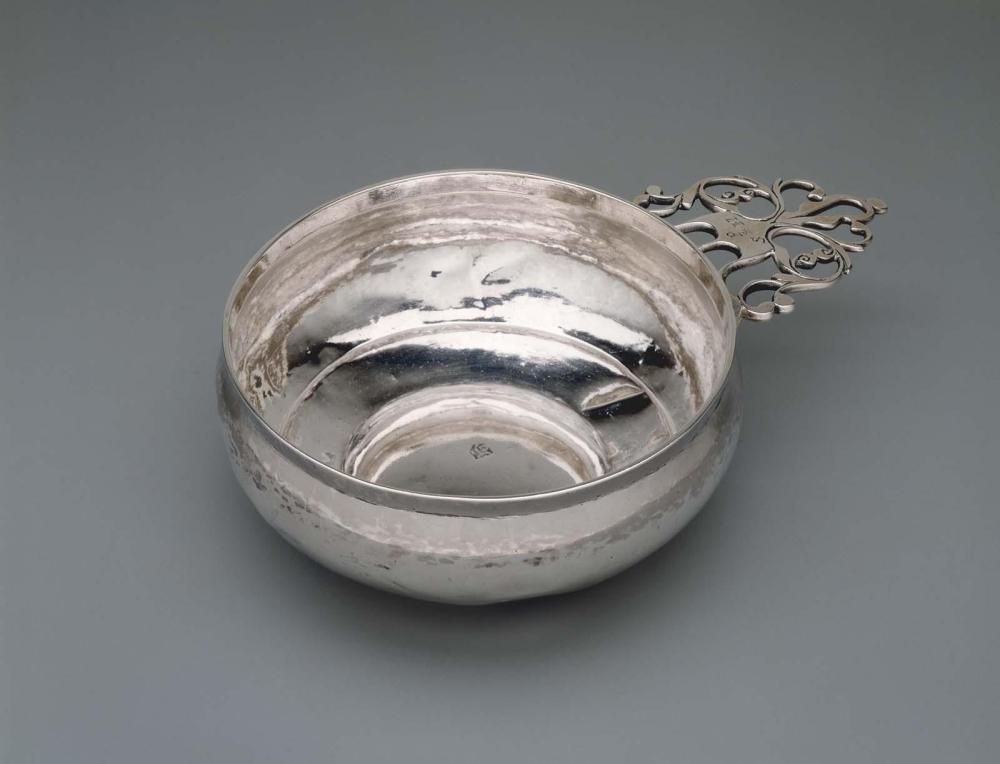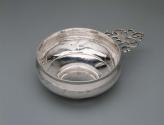Advanced Search
Porringer
George Hanners, Sr. (American, about 1696–1740)
1720–30
Object Place: Boston, Massachusetts
Medium/Technique
Silver
Dimensions
4.8 x 20.4 cm (1 7/8 x 8 1/16 in.)
Credit Line
Gift of Mrs. Elliot P. Cogswell
Accession Number1991.662
NOT ON VIEW
CollectionsAmericas
ClassificationsSilver hollowware
George Hanners Sr. may have trained under Boston silversmith Andrew Tyler (1692/93 – 1741), for he witnessed the will of Tyler’s mother in 1716/17. He had artisanal dealings with silversmiths Thomas Mullins (1680 – 1744) and Benjamin Hiller (1687/88 – about 1745) and in 1739 successfully sued Thomas Townsend (1703/4 – 1757) for nonpayment for a ring, tankard, gold, several pounds of allum, and two nests of crucibles. The suit demonstrates Hanners’s ability to produce hollowware and jewelry for others to retail and to provide supplies to fellow craftsmen.
During his short career, spent “at his House at the Dock-Head, Boston,” Hanners produced much hollowware but comparatively little flatware. He fashioned mourning rings, as noted in at least two estate records, for which he may have used the “Deaths head Stamp” listed in the detailed inventory of his tools. Hanners made ecclesiastical silver for Second Church, Boston; First Church, Woburn; and other congregational churches farther afield in Greenland, New Hampshire, and Branford, Connecticut.
This porringer and its related silver tankard (cat. no. 62) were made for the Rev. Samuel Phillips and his wife, Hannah (White), of Andover, a few years after their marriage in 1711. The two pieces were nearly contemporaneous, as is suggested by the distinctive notations found on each base, possibly in Hanners’s own hand. The scratch weight engraved on the tankard’s base, typically a guide to an object’s original weight, is twelve ounces more than its current weight, proving that the lid was later removed. Despite this lack, the presence of two rare “GH” touches within rectangles, together with a pair of Hanners’s better-known shield marks, make this work an extremely rare and significant document of the silversmith’s skill.
This text has been adapted from "Silver of the Americas, 1600-2000," edited by Jeannine Falino and Gerald W.R. Ward, published in 2008 by the MFA. Complete references can be found in that publication.
During his short career, spent “at his House at the Dock-Head, Boston,” Hanners produced much hollowware but comparatively little flatware. He fashioned mourning rings, as noted in at least two estate records, for which he may have used the “Deaths head Stamp” listed in the detailed inventory of his tools. Hanners made ecclesiastical silver for Second Church, Boston; First Church, Woburn; and other congregational churches farther afield in Greenland, New Hampshire, and Branford, Connecticut.
This porringer and its related silver tankard (cat. no. 62) were made for the Rev. Samuel Phillips and his wife, Hannah (White), of Andover, a few years after their marriage in 1711. The two pieces were nearly contemporaneous, as is suggested by the distinctive notations found on each base, possibly in Hanners’s own hand. The scratch weight engraved on the tankard’s base, typically a guide to an object’s original weight, is twelve ounces more than its current weight, proving that the lid was later removed. Despite this lack, the presence of two rare “GH” touches within rectangles, together with a pair of Hanners’s better-known shield marks, make this work an extremely rare and significant document of the silversmith’s skill.
This text has been adapted from "Silver of the Americas, 1600-2000," edited by Jeannine Falino and Gerald W.R. Ward, published in 2008 by the MFA. Complete references can be found in that publication.
DescriptionThe porringer has a small center dome and inclined base leading to convex sides and everted rim. The cast keyhole-style handle bears cast and chased decoration. Dents are visible in the sides directly opposite from and to proper right of handle, and a sharp dent appears on the base, below handle.
Marks
Marked "GH" in Roman capitals in a crowned shield with a device below, near center point inside porringer.
InscriptionsOn handle, with initials facing away from bowl, "P / S * H" in shaded Roman capitals. On base "oun / 7" and "pw / 7 -" with star between.
ProvenanceAccording to the donor, the initials are those of the Rev. Samuel Phillips (1689 – 1771) of Andover, Massachusetts, m. Hannah White (1691 – 1775) of Haverhill in 1711/12. By descent to their daughter Lydia Phillips (1717 – 1749) and Dr. Parker Clark (b. 1718), m. 1742; Lydia was the sister of Samuel and John Phillips, founders of Phillips Academy, Andover. To their daughter Hannah Clark (1743 – 1832) and Dr. Edward Russell (1736 – 1785) of Andover, m. 1767; to their son Gen. Edward Russell (1782 – 1835) and Lucy Stevens (1787 – 1870), m. 1812; to their daughter Margaret Elizabeth Russell (1815 – 1860) and the Hon. Charles Northend Cogswell (1797 – 1843), m. 1839. To their son Dr. Edward Russell Cogswell (1841 – 1914) and Sarah Parks Proctor (d. 1907), m. 1864; to their son Dr. George Proctor Cogswell (1867 – about 1953) and Anna Willis Bumstead, of Cambridge, Massachusetts, m. 1895; to their son Elliot Proctor Cogswell (1905 – 1988) and the donor, Marion Park (1907 – 1995), of Weston, Massachusetts, m. 1930.



